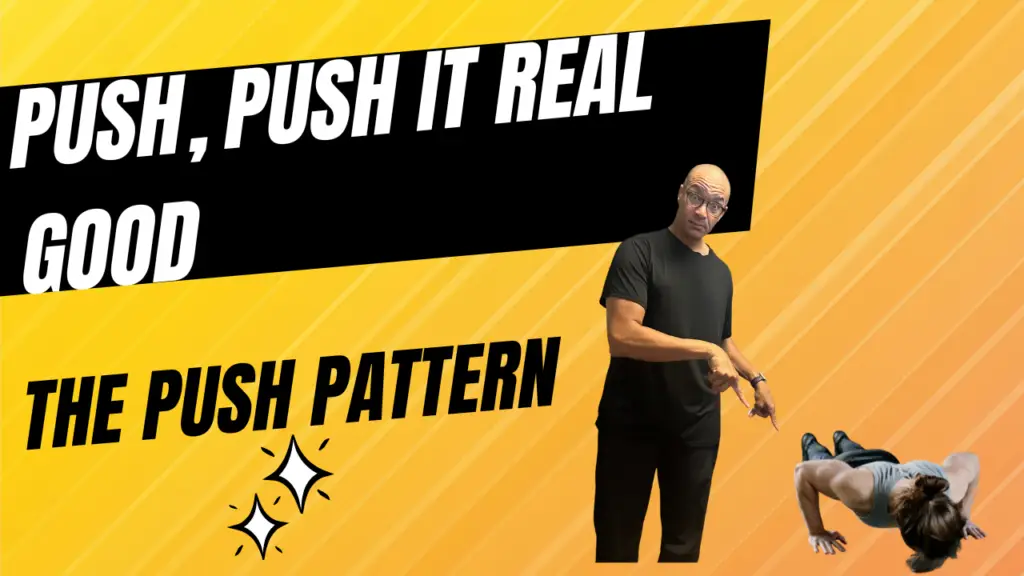Mastering the push-pattern. The bench press. The chest press. The push-up.
Whatever you call it, this push pattern is one of the seven primal movements—and it’s about a lot more than just building your pecs.
In this post (and video), we’ll explore how mastering the push pattern isn’t just a matter of technique, but of understanding the full-body biomechanics behind it. When you treat it as a holistic movement, you unlock strength, mobility, and injury resilience across your entire body.
Check out the full video by clicking on the image below.

The Push Pattern Is a Full-Body, Compound Movement
Yes, the push pattern trains your pecs—but it also demands the coordination of your:
- Lats
- Deltoids
- Biceps & triceps
- Forearms, wrists, and hands
- Elbows, shoulders, and spine
- Rib cage, sternum, and even your pelvis
When you perform a push correctly, these systems integrate through your fascia to create a strong, stable, and safe motion.
But when you lack strength or coordination in any of these areas, your body compensates. That’s where problems start.
Compensation = Cheating Your Body
Let’s say your pecs are underdeveloped. You can still bench press—but your body cheats by overusing the lats, delts, or even your spine.
Over time, this imbalance leads to:
- Shoulder pain
- Poor posture
- Limited progress
- Injury
To avoid this, you must train the push pattern segmentally first—then globally.
Segmental Training Before Full Patterns
Instead of jumping straight into compound movements, train the individual components:
- Pec flies at diagonal angles to match muscle fiber lines
- Serratus anterior strength (fan-shaped movement)
- Rhomboid work in glenohumeral-friendly positions
- Posterior chain and thoracic posture development
- Psoriatic joint mobilization and therapy (behind shoulder blades)
This builds neuromuscular coordination, muscle mass, blood flow, and fascial integration—giving your body the tools to execute the push without compensation.
Choosing the Right Push Pattern Progression
Once you’ve built the foundation, you can progress the push pattern intelligently:
- Open chain (free end movement): barbell bench press, dumbbell press
- Closed chain (fixed end): push-ups from wall, bench, knees, or toes
- Unilateral (one side): single-arm press
- With rotation or combination: functional push + twist variations
Start with the basics. Don’t jump into complexity without preparation—your body will guess, and guessing equals injury.
Posture and Scapular Mechanics: Two Common Mistakes
Two things I see people get wrong constantly:
- Posture
- Arching the back during a press
- Leading with the head during push-ups
- Lifting the head off the bench
- Dropping the pelvis or changing spinal curves
- Scapular Mechanics (Shoulder Blade Movement)
- On the way down (eccentric), scapulae must retract
- On the way up (concentric), they must protract
If your scapulae can’t glide properly, your shoulders take the hit.
The Serratus Anterior: The Unsung Hero of Push Movements
The serratus anterior is critical for scapular protraction and stabilization. It fans out from the ribs to the shoulder blade and works alongside:
- Rhomboids (between the scapulae)
- Psoriatic joint (behind the scapula)
You must train it in multiple planes—not just with “push-ups plus,” but in diagonal and rotational movements to build full range and resilience.
We have a great guide to understanding holistic exercise and fitness
Why Mastering the Push Pattern Matters
This isn’t just about looking better in a t-shirt. The push pattern shows up in:
- Daily movements (pushing open a door)
- Sports performance
- Fall prevention
- Structural balance
- Joint health
When you rush into it without preparing the body segmentally, you’re skipping steps—and your body will force you to pay attention later through pain or dysfunction.
Final Thoughts (and Your Next Steps)
Mastering the push pattern means respecting the complexity of your body.
✅ Train weak links first
✅ Stretch and mobilize where needed
✅ Build strength from the ground up
✅ Respect posture, control, and sequencing
📥 Free Resource + Call Option
🎁 Want to train smarter, not harder?
Get my free guide: 4 Steps to a Strong, Pain-Free Body to Live the Life You Choose — instant access.
Building a foundation for a better life.
Find out more @

Leave a Reply